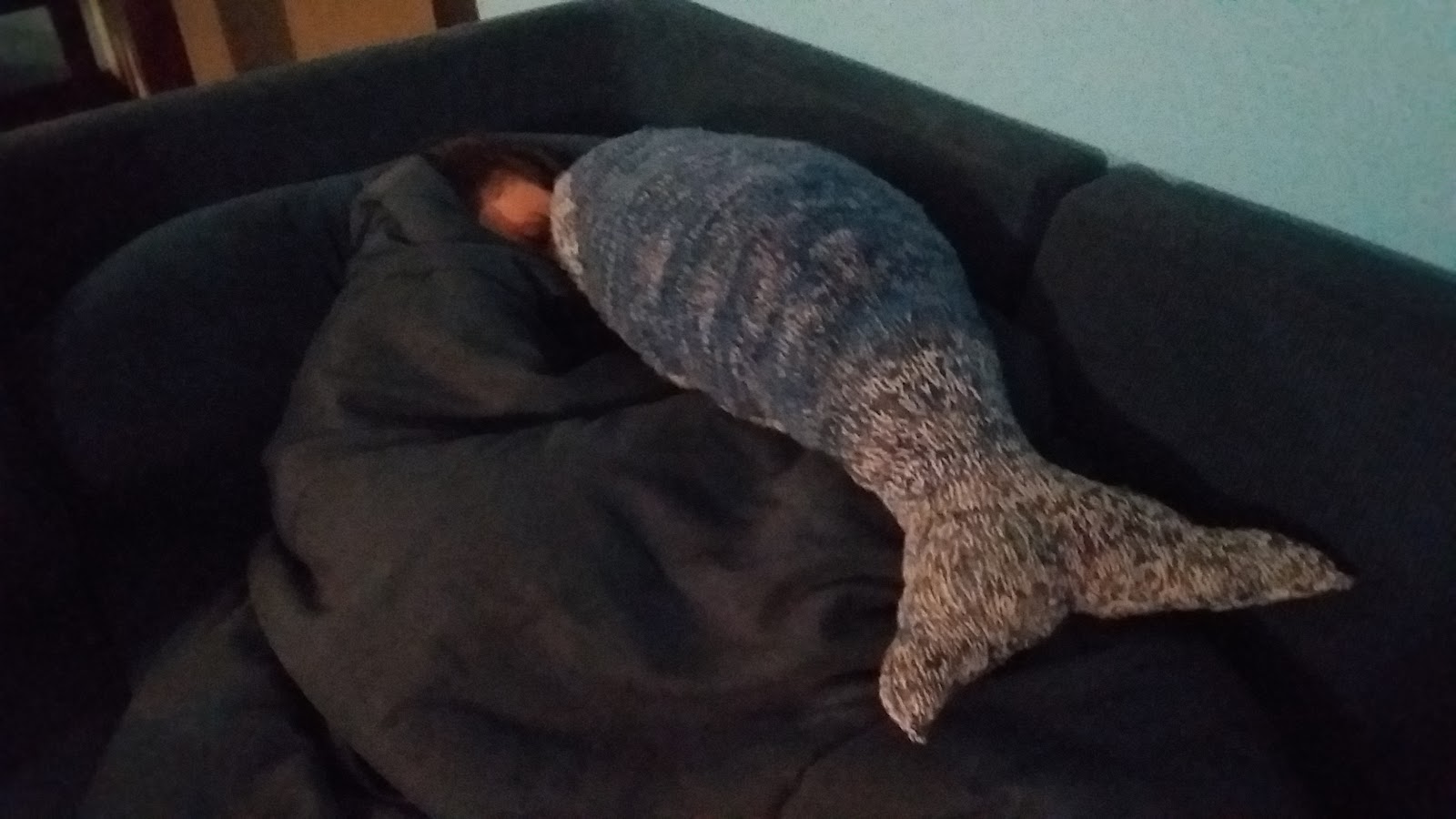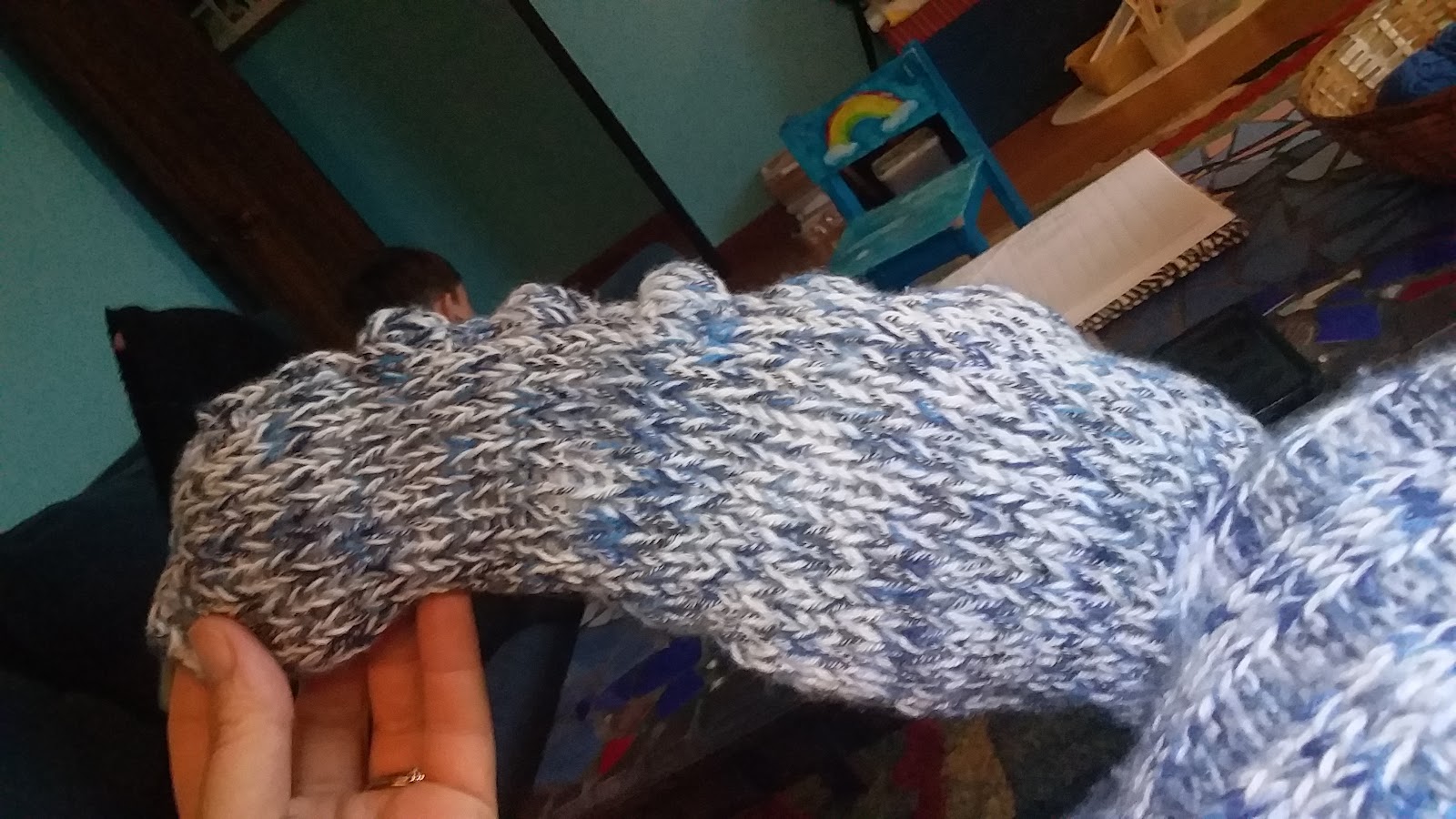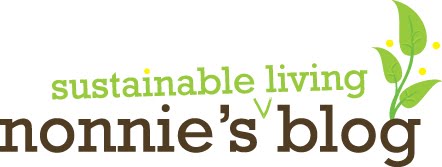It was a whale of a project.
But I wanted to express to my sister how much I loved her, from far away. (I live in NZ, she in North America. She had also just given me some super valuable advice and had always helped me so I wanted to show her how much I cared. Also, wouldn't that be a funny thing to get in the mail?
I restarted several times figuring out the best way to proceed.
I normally knit in the round, and after many sea creatures like dolphins, start at the nose and expand or shape at will. It is seamless. It is like a sculpture.
But the humpback tended to the 2D sew-it-together approach as it seems like there are two colours, one on its base, another on top. Also the mouth wraps around up high on the whale. After trying a few times switching colours but knitting round I gave up on that and calculated the 3D shape as best I could, mapping put the area around the whale and making a knitting graph of the top and bottom (based on actual tension). I drew the flanking shapes - lower half shaped like an arrowhead, the top like a bottle starting narrow and staying narrow for awhile then expanding.
The graph and the drawing were super helpful but for some reason I figured it wasn't quite wide enough - too realistic - so I multiplied the stitches by 33% wider...
This was the result.
This is the start of the base (baleen) piece- really big ribbing to show those grooves...
I recorded what I was knitting - eventually sewing both parts together, stuffing it and continuing the second half in freestyle- leaving caps to return to for adding the fins.
Every part required several tries, the start (5), the joining, the tail (twice). The fins of course - but when I elaborately spent an evening following the scalloped edge on a fin, this is the most important part to write down as nature is syymmetrical. I can freestyle the body all I want, but the second fin must copy the first exactly (mirrored). And the left side of table in to right. So it must be written down - even just for the moment until it is complete.
Kind eyes need eyelids; I always enjoy adding soul to the animals doing this part. Eyes are the most important to be done right.
After all was complete adding bumps and even the top fin through shaping added lots of whale character.
I may not have made a realistic humpback whale, I think following such a bumpy type of whale (while shortening the proportions) allowed me to make a very whale-like whale!
My sister has always loved blue, and I used a few strands of blue sock wool, and he same but part white on the base. When she got this in the mail - it was a whale of a hug!
By the way here is the pattern I painstakingly recorded. I hate following patterns myself, but just in case! Well they are a great way to learn technique.
Pattern:
Bottom of humpback whale
Cast on 16 sts
Knit in rib 16 sts
Add 2 each side, rib 20
Rib 20
Add 2 each side, rib 24
Rib 24
Add 2 each side, rib 28
Rib 28
Add 2 each side, rib 32
Rib 32
Rib 32
Add 2 each side, rib 36
Rib 36
Rib 36
Rib 36
Add 2 each side, rib 40
Rib 40 start double ribbing 2k2p
Rib 40
Rib 40
Add 2 each side, rib 44 2p2k first
Rib 44 stil 2p2k first
Add 1 each side, rib 46 care for ribbing as 1 extra (Kfb, p, 2k2p…)
Rib 46 starting k1 p2 k2
Rib 46
Rib 46
Rib 46
Add 1 each side, rib 48
Rib 48 switch bigger needles
Rows 28 - 48, continue double rib 48 for 12 rows, then change to
49. K or p2tog 7 times following pattern, then continue pattern until 14 left, k or ptog 7 times following pattern
50. K2tog, p2tog, k2tog, continue pattern until last 6 - k2tog or p2tog 3 times with pattern
51. K2tog twice, follow pattern to last 4; k2tog twice (24)
52. P1, k2, p3 etc until last 3, 2p, k1
53 - 55 Continue in triple rib for 3 rows then reduce 1 more each end. (22)
Knit in pattern for 48 rows or until narrow part measures about 30 cm.
103. Switch to double rib again to fade out indents - *(2k2p) repeat until end of row (but ends on a 2k)
104. Start with 2p2k. Repeat to end, but ends on a 2p.*
105-106. Repeat rows 103/104 double rib pattern once more.
107. K2tog,(2p2k) until last 4, then 2p, k2tog. 20
108. P1, (2k2p) repeat until last 4, then 2k, p1. 20
109. K2tog, p1, (k2p2) until 3 left, p1, k2tog. 18
110. (2k2p) repeat, ends on a 2k. 18
111. (2p2k) repeat, ends on 2p. 18
112. K2tog, (2p,2k) until end. 17
113. K2tog, (2k, 2p) until last 3, k1, p2tog 15
114. K1, p1, (k2, p2) until last sts k1.
115. P1, (2k, 2p) until last 2, k2tog. 14
116. P1, (k2, p2) repeat until last 1 then k1.
117. K2tog, k1, p2, (k2, p2) until last 3, p1, k2tog. 12
118. (2k, 2p) until end.
119. K2tog, (2p, 2k), until last 2, p2tog. 10
120. K1, p2, k2, p2, 2k, p1.
121. K2tog, p1, k2, p2, k1, p2tog. 8
122. K1, p1, k2, p2, k2 (8)
123. P2, k2, repeat.
124. P2, k2, repeat
Put sts on hold
Top of humpback whale
Cast on 8 sts
K8
P3, kfb twice, p3 (10)
Kfb, k8, kfb (12)
P3, kfb, p4, kfb, p3 (14)
Kfb, p12, kfb (16)
jKfb, p14, kfb (18)
K8, kfb twice, k8 (20)
Kfb, p18, kfb (22)
K10, kfb twice, k10 (24)
Kfb, p23, kfb (26)
K7, kfb, k10, kfb, k7 (28)
P28
K13, kfb twice, k13 (30)
P30
K30
P30
Kfb, k30, kfb (32)
P32
K32
P32
K3, kfb, k to last 4, kfb, k3. (34)
P34
K34
K2tog, p to last st, k2tog (36)
K36
P36
K12, kfb, k10, kfb, k12 (38)
P38
K38
Kfb, p38 (until last st), kfb
P40
K40
P40
CO 10 to right side, k to end, .CO 10 sts
P60
K29, kfb twice, k29 (62)
P62
K62
P62
Kfb, k to last st, kfb
P64
Stockinette until matches bottom piece then sew together leaving holes for side fins and knit in round again.
Narrow tail by eye looking at photos of whale.

Whale tail
When at most narrow (48 sts) start increasing - also knit more rows below so tail will be slightly lifted up(like when the breach).
Over 16 rounds increase to 82 total (I turned and knitted more rows on underside than top).
Method for knitting tail - when stitches are evenly divided onto 4 needles, knit with 2 at a time, other 2 on hold.
For a few rows, reduce k2tog x 2 at beginning (closest to tail centre), then increase by 1 at tail edge on end of needle, again at end of next needle, then k to last four of round at k2tog x 2 again.
Then k2tog at start and end of rounds with no increases at edge until all stitches gone - draw string through last two.
Repeat on other side.

Whale fin - right (according to whale)
Doesn't matter what you do just write down and mirror exactly as fins are symmetrical!
Right side, round starts by eye, bottom needle first to the left...
Stick needle in round hole, pu 14 sts top, 14 bottom
k 4 rounds
k28
k28
k28
k28
Increase by 2 on bottom (16) and by 4 on top (18) 34 sts
k 8 rounds
k34
k34
k34
k34
k34
k34
k34
k34
n1 bot: Kfb by eye, k2tog at end (tail). n2 top: k to last st, kfb by eye. (35)
k round
k round
n1 bot: k2tog by eye, k to end of round
n1 bot: k2tog x 2 by eye, k. n2 top: k to last 2 and k2tog (by eye).
n1 bot: k. n2 top: k2tog by tail and k2tog x 3 by eye.
k28 (15 bot n / 13 top)
n1 bot: k. n2 top. k to last 2 and kfb x 2 (by eye).
n1 bot: k. n2 top: k to last 2, kfb x 2 (by eye).
n1bot: k to last 2, k2tog (by tail). n2 top: k.
k29 (14 bot / 15 top)
n1bot: k2tog by eye, k to end. n2 top: k to last 4 sts, k2tog x 2 by eye.
n1 bot: k2tog by eye, k to end. n2 top: k2 tog by tail, k to end. 24 sts
kfb x 2 at start and end of round (by eye)
k28
n1 bot: k to last 2, k2tog (by tail). n2 top: k. 27 sts
k2tog x 2 at start and end of round (by eye) 23 sts
n1bot: k2tog by eye, k. n2 top: k. 22 sts
k22 (10 bot, 12 top)
k22
k22
n1 bot: k to end. n2 top: k2tog by tail, k.
k21
k21
kfb start and end (by eye).
k23
k23
k2tog at start and end of round (by eye)
k 6 rounds
k21
k21
k21
k21
k21
k21
kfb at start and end f round (by eye)
k23
k2tog x 2 at start and end of round (eye)
k2tog at start and end of round (eye)
k2tog x 2 at start and end of round (eye)
k2tog x 3 at start and end of round (eye)
k2tog x 4
k2tog x 2
draw string through 2 sts
tidy up corner
shape and stuff bumps, reinforce, look at photo whale fin
other fin - round starts by eye but is top needle first. replicate (mirror)
That's it!
























